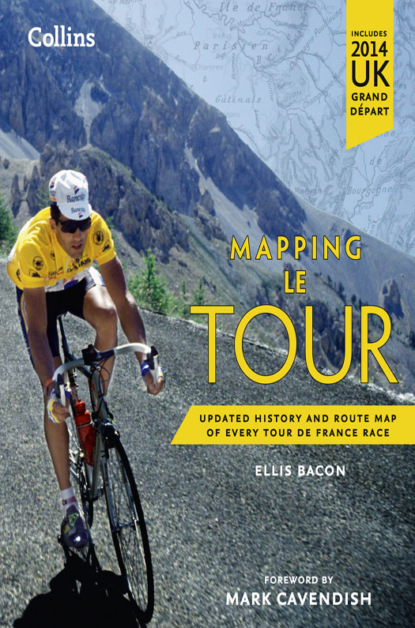По всем вопросам обращайтесь на: info@litportal.ru
(©) 2003-2024.
✖
Mapping Le Tour: The unofficial history of all 100 Tour de France races
Настройки чтения
Размер шрифта
Высота строк
Поля
The inclusion of Pyrenean climbs takes its toll on a shattered Octave Lapize as he reaches the summit of the Col du Tourmalet during stage 10
1911 (#ulink_8745b11a-9614-5f47-b142-89979717aa44)
9th Edition (#ulink_8745b11a-9614-5f47-b142-89979717aa44)
“Oh Sappey, oh Laffrey, oh Col Bayard, oh Tourmalet … You are nothing compared to the Aubisque.”
Henri Desgrange congratulates himself for having organised such a spectacular 1911 Tour
With Pyrenean climbs appearing for the first time in the 1910 Tour, it was only natural that the 1911 Tour should visit France’s other great mountain range, the Alps.
As it had been every year since 1905, the climb of the Ballon d’Alsace was on the menu again, but stage 5 saw the riders face nothing short of an epic day as they tackled the Col des Aravis, the Col du Télégraphe, the Col du Lautaret and the monstrous Col du Galibier – all now today very familiar and oft-used climbs in the Tour.
Despite the anger of the previous year at having been sent over such an inhumane route as that through the Pyrenees, and despite the Alps being higher and arguably harder, the riders surprised even themselves by being dazzled by the beauty of these new Alpine climbs.
Émile Georget – who was to eventually finish third overall – was the first over the top of a still-snow-covered Galibier, having heaved his way up its muddy, unmade roads. He held his lead all the way to the finish of that fifth stage between Chamonix and Grenoble, too, taking the stage win over Paul Duboc by a whopping 15 minutes.
There was a step backwards, however: Germany no longer allowed the race to cross its borders and, with no Swiss visit this time, the race remained entirely within the borders of France.
Gustave Garrigou battles the Col d’Aubisque on his way to overall victory
1912 (#ulink_8745b11a-9614-5f47-b142-89979717aa44)
10th Edition (#ulink_8745b11a-9614-5f47-b142-89979717aa44)
The 1912 Tour followed the same route as the 1911 edition, save for a slightly shortened sixth stage. This time, the French fans’ hero was to be Eugène Christophe, who effectively replaced Émile Georget in their hearts after the third-placed finisher in 1911 abandoned on the third stage of the 1912 race.
Christophe’s was a name that was about to become synonymous with the Tour de France for a number of reasons in the years following the 10th edition of the race, but became legendary enough in 1912 when the French rider staged the race’s longest-ever successful breakaway.
Just as Georget had done the year before, it was Christophe who led the race over the Aravis, Télégraphe, Lautaret and Galibier as part of a 315-km (196-mile) break, winning in Grenoble with only two-and-a-half minutes to spare over countryman Octave Lapize.
With that 315 km (196 miles) being around 100 km (62 miles) longer than any complete stage in the modern era, it’s not going to be beaten any time soon – read, ever.
By virtue of winning three stages – stage 4 by a considerable margin of more than 13 minutes – it’s likely that Christophe would have won the race overall in 1912 had it been contested on time. Instead, for the final time that it was decided on points, it was Odile Defraye who became the first ever Belgian winner of the Tour, easily beating Christophe for consistency by finishing in the top ten on every one of the race’s fifteen stages, bar one.
From 1912 on, Belgian riders would come to play a huge part in the race’s success and history.
Eugène Christophe on his incredible 315-km breakaway
1913 (#ulink_8745b11a-9614-5f47-b142-89979717aa44)
11th Edition (#ulink_8745b11a-9614-5f47-b142-89979717aa44)
As well as reverting back to cumulative time rather than points deciding the race’s overall winner, the Tour headed off from Paris for an anti-clockwise circuit of France for the first time in 1913. That said, it followed an extremely similar route to the previous two editions of the race, visiting almost all of the same towns, from the other direction.
Some went as far as to say that organiser Desgrange’s decision to revert to time as the measure of his race’s winner was in an effort to help a Frenchman win – namely Eugène Christophe, runner-up in 1912.
However, what happened to Christophe on stage 6, on the road between Bayonne and Luchon, soon put the kibosh on that theory. While descending the Col du Tourmalet, Christophe’s forks snapped, requiring him to run the rest of the way down the mountain to the town at the bottom – Ste-Marie-de-Campan – where he found a blacksmith willing to allow him to use his tools to effect a repair. However, the fact that the blacksmith’s assistant operated the bellows to help Christophe contravened race rules that stipulated that a rider couldn’t receive any outside assistance.
The Frenchman was handed a time penalty, and Belgian rider Philippe Thys went on to win the race by just eight-and-a-half minutes over Frenchman Gustave Garrigou, meaning that, for the second year in a row, there was a foreign winner, which wouldn’t have pleased an organiser trying to promote a French newspaper to a French public.
In fact, Belgian riders would win the race seven times in a row before a French rider would win his home race again.
Anyone who thinks that today’s maladie of there having been no French winner since 1985 need only look to the past to see that everything goes in cycles.
Eugène Christophe’s repairs are in vain as he is subsequently penalised for accepting outside assistance
1914 (#ulink_8745b11a-9614-5f47-b142-89979717aa44)
12th Edition (#ulink_8745b11a-9614-5f47-b142-89979717aa44)
After 1913’s relatively close finish to the race, reigning champion Philippe Thys started the 1914 Tour in earnest, winning the sprint from an eleven-man lead group on stage 1,and then never letting go of the lead again. It looked as though it was going to be a dominating show of riding from the Belgian.
Sure enough, Thys had built up a 35-minute lead over Henri Pélissier, a 25-year-old Frenchman riding his first Tour de France, by the time the race exited the Pyrenees. Pélissier pushed the race leader hard in the Alps, but had only been able to reduce his deficit by a few minutes going into the fourteenth and penultimate stage between Longwy and Dunkirk.
Thys, however, was docked 30 minutes for an illegal wheel change on the stage, and Pélissier trailed Thys by just 1 minute 50 seconds when they reached the finish in the Parc des Princes in Paris the next day, having won three stages along the way.
The 1914 Tour also saw the first participation by an Australian rider, with two of them – Don Kirkham and Iddo ‘Snowy’ Munro – lining up together for the off in Paris at the end of June.
Both made it all the way around and back to Paris, in seventeenth and twentieth place, respectively, but another foreign rider, poor Ali Neffati – a Tunisian riding his second Tour who had garnered a number of fans for choosing to wear a fez while he rode – was less fortunate, hit by one of the organisation’s cars on stage 6, and forced to abandon for the second year in a row.
Two days after the race finished in Paris, Austria-Hungary declared war on Serbia, following the assassination of Archduke Franz Ferdinand a month earlier, on the day the Tour had started. The First World War would put paid to the Tour de France for the next five years.
Debutant Henri Pèlissier races from Grenoble to Geneva
1919 (#ulink_243e008e-0037-5637-ab0b-dc7c054278e7)
13th Edition (#ulink_243e008e-0037-5637-ab0b-dc7c054278e7)
“No rider deserves it more than he does.”
Henri Desgrange on Eugène Christophe’s credentials for being the first rider ever to wear the Tour’s yellow jersey
The Tour resurfaced with a cold, wet and just downright miserable schlep of a 1919 edition through a war-ravaged France. Three past winners – Lucien Petit-Breton, François Faber and Octave Lapize – had been killed during the First World War, and many of the riders arrived at the race weary and out of shape, which was said to have contributed to what was, and remains, the Tour’s slowest ever average speed: 24.056 kph (14.948 mph).
It won’t have helped, either, that the organisers saw fit to include the race’s longest-ever stage: a 482-km (300-mile) route between Les Sables-d’Olonne and Bayonne. It was a stage the race would then use every year until 1924; it was common in the early years of the Tour to repeat stages year after year, but today, with competition between towns to host stages fierce, the race follows a different route every year.
French darling Eugène Christophe was back in 1919, as was defending champion Philippe Thys, winner in 1913 and 1914. Thys, however, soon abandoned, ill, on stage 1; he’d be back the following year. Christophe, though, took over the race lead from compatriot Henri Pélissier after stage 4.
After six stages at the head of the race, Christophe was awarded a yellow jersey by race organiser Henri Desgrange at the café L’Ascenseur in Grenoble, at the start of stage 11 on 19 July. The choice of colour to identify the race leader was in order to further publicise Desgrange’s newspaper, L’Auto, which was printed on yellow paper.
Christophe held the maillot jaune for another four stages before bad luck hit. Ironically, just as they had done in 1913 on the Tourmalet, Christophe’s forks broke while riding the cobbles between Metz and Dunkirk on stage 14, forcing him to fix them and cede the race lead – and the jersey – to Belgium’s Firmin Lambot, who wore it, and defended it, on the next day’s final stage to Paris.
Firmin Lambot is congratulated after claiming the yellow jersey in Dunkirk
1920 (#ulink_243e008e-0037-5637-ab0b-dc7c054278e7)
14th Edition (#ulink_243e008e-0037-5637-ab0b-dc7c054278e7)





